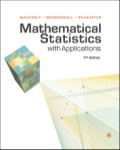
a.
Obtain the expression
a.
Explanation of Solution
In this context, it is assumed that the assumptions associated with a multinomial experiment are all satisfied. Based on Section 5.9, each of the
The value of the expression
b.
Provide the unbiased estimator of
b.
Explanation of Solution
From Part (a),
Then,
An unbiased estimator for
c.
Verify that
c.
Explanation of Solution
It is known that
Now,
Hence, it has been verified that
d.
Obtain the variance of unbiased estimator with reference to Part (c).
d.
Explanation of Solution
From Part (a),
Then,
e.
Obtain the consistent estimator of
e.
Explanation of Solution
A consistent estimator for
f.
Verify that a large sample
f.
Explanation of Solution
It is known that the variable
Since
Now,
In this context, it has been showed that a transformation of
Therefore,
Want to see more full solutions like this?
Chapter 14 Solutions
EBK MATHEMATICAL STATISTICS WITH APPLIC
 College AlgebraAlgebraISBN:9781305115545Author:James Stewart, Lothar Redlin, Saleem WatsonPublisher:Cengage LearningAlgebra & Trigonometry with Analytic GeometryAlgebraISBN:9781133382119Author:SwokowskiPublisher:Cengage
College AlgebraAlgebraISBN:9781305115545Author:James Stewart, Lothar Redlin, Saleem WatsonPublisher:Cengage LearningAlgebra & Trigonometry with Analytic GeometryAlgebraISBN:9781133382119Author:SwokowskiPublisher:Cengage

